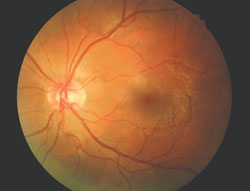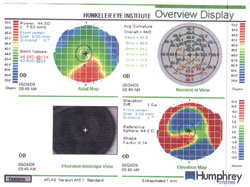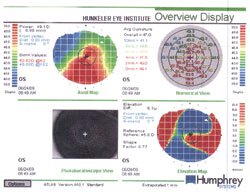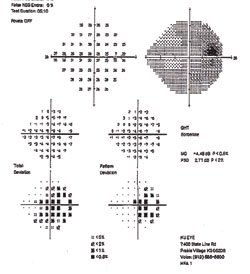Patient has worsening vision, corneal thinning, optic nerve hyperemia
 Jayme Fose |
A 34-year-old white male presented to our clinic with a chief complaint of blurry vision, gradually worsening, in both eyes over the past 3 to 4 months. He denied headache or pain in or around his eyes. He was also interested in wearing contact lenses.
The patient’s medical history was unremarkable. His habitual prescription was +0.25 D -0.50 D x 073, 20/40 OD and +0.50 D -1.00 D x 139, 20/30 OS. His manifest refraction was +2.00 D -1.00 D x 061, 20/30 OD and -0.75 D -1.25 D x 140, 20/25 OS.
  Fundus examination of the right eye (top) showed grade 2 edema and mild hyperemia of the optic nerve head with a 0.15 round cup-to-disc ratio. Choroidal folds and retinal wrinkling were noted temporal to the disc. The posterior pole was normal in the left eye. Images: Fose J |
Retinoscopy showed scissor reflexes in both eyes. Refraction revealed an unstable prescription and variable acuity. Extraocular motility was normal, without pain or diplopia. Pupils were equal and reactive to light without an afferent pupillary defect (APD).
Slit lamp examination demonstrated inferior corneal thinning and a positive Munson’s sign on down gaze in both eyes. Otherwise, the anterior segment was unremarkable. IOP was 10 mm Hg in each eye.
 HRR color testing revealed protan and deutan color deficiencies. |
HRR color testing revealed protan and deutan color deficiencies. Upon further questioning, the patient noted a history of “color blindness.” Because congenital dyschromatopsia was present, color testing could not be used to gauge optic nerve function.
Fundus examination of the right eye showed grade 2 edema and mild hyperemia of the optic nerve head with a 0.15 round cup-to-disc ratio. Choroidal folds and retinal wrinkling were noted temporal to the disc. The posterior pole was normal in the left eye; the disc appeared flat with a cup-to-disc ratio of 0.30 horizontal by 0.25 vertical.

What is your diagnosis?
The anterior findings suggested either pellucid marginal degeneration or keratoconus. Differential diagnoses for the posterior findings included epiretinal membrane with traction, serous retinal detachment, papilledema, papillitis, optic neuropathy, retro-orbital tumors and buried drusen.
Pellucid marginal degeneration typically presents with high against-the-rule astigmatism; the keratometry readings showed high with-the-rule astigmatism, which suggested keratoconus.
Retinal detachments and epiretinal membranes could lead to wrinkling and folds, but do not involve edema of the optic nerve head. Papilledema is an increase in the intracranial pressure causing elevation of the optic nerve head, which occurs bilaterally. Papillitis and optic neuropathy usually present with greatly reduced acuity and color defects. Pain on eye movement is usually present, and an APD may be seen. Buried drusen will not cause hyperemia or retinal wrinkling.
  The images show inferior corneal steepening and high against-the-rule astigmatism in both eyes, which is consistent with keratoconus. |
My final diagnosis was suspected retro-orbital mass, which was pressing on the optic nerve and the posterior wall causing disc edema, choroidal folds and a hyperopic shift. I ordered an orbital CT and referred the patient to a neuro-ophthalmologist. I also requested topography to verify keratoconus.
The images show inferior corneal steepening and high against-the-rule astigmatism in both eyes, which is consistent with keratoconus. We decided to postpone fitting contact lenses until the posterior findings were addressed.
A Humphrey 24-2 visual field (Carl Zeiss Meditec, Dublin, Calif.) was also performed on both eyes. The right eye demonstrated an enlarged blind spot, while the left eye showed no defects.
The neuro-ophthalmologist who examined the patient was not convinced that a retro-orbital mass was present. He suspected a retinal detachment or inflammatory papillitis. He referred the patient to a retinal specialist, who ordered an optical coherence tomography and fluorescein angiography.
  The right eye (top) showed an enlarged blind spot; the left eye appeared normal. |
OCT of the right eye demonstrated normal retinal thickness, suggesting the folds were choroidal in nature. It also indicated mild thickening of the nerve fiber layer in the region of the optic disc. Fluorescein angiography revealed mild disc leakage in the right eye while the left eye appeared normal. After ruling out retinal causes, the retinal specialist referred the patient to another colleague to complete an inflammatory work-up. He also had the CT scan completed.
A large mass centered within the right sphenoid sinus was present. It had eroded the lateral wall of the right sphenoid sinus and extended into the right orbital apex and optic canal. The mass extended into the left sphenoid sinus, pituitary fossa and ethmoid air cells, as well as through the right pterygioid plates. The mass also surrounded the right cavernous carotid artery.
The mass was removed without complication, and a biopsy was performed. Staining of the specimen indicated Aspergillus.
At his postoperative visit, the patient’s best-corrected acuity was 20/60 in the right eye and 20/25 in the left eye. The blind spot had decreased to about half the original size, and the appearance of the optic nerve had dramatically improved. The choroidal folds were still present, but no subretinal fluid was evident.
The patient returned to me for a contact lens fitting 2 months later. The new gas-permeable contact lenses provided the patient with 20/30 acuity in the right eye and 20/25 acuity in the left eye. He is doing well in his lenses, and his ocular health appears normal with some residual choroidal folds in the right eye.

- Jayme Fose, OD, practices at Eye Associates in Overland Park, Kansas. She can be reached at drfose@gmail.com.
- Leo P. Semes, OD, is a professor of optometry, University of Alabama at Birmingham and a member of the Primary Care Optometry News Editorial Board. He may be contacted at (205) 934-6773; fax: (205) 934-6758; lsemes@uab.edu.
- Disclosure: Dr. Fose has no direct financial interest in the products mentioned in this article, nor is she a paid consultant for any companies mentioned.
